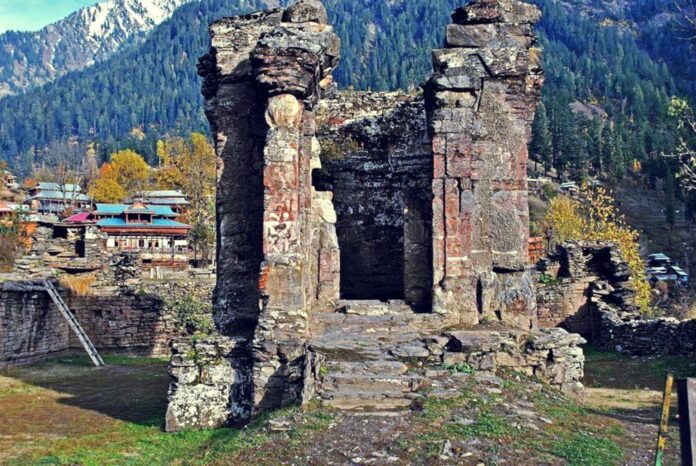When Adi Shankaracharya ji had won the shastrarth in Sharadamba Peetha in Kashmir, he had requested Maa Sharadamba to accompany him all the way back home to Kaladi in Kerala. Sharadamba manifested herself in front of Adi Shankara ji and agreed but on one condition — that there would be no looking back.
By Rohit Pathania
Adi Shankara ji agreed, and the long, arduous journey from Kashmir to Kaladi began.
While he did not look back once, at every step Adi Shankara could listen to the ear-pleasing sounds of the Devi’s nupur (anklets) accompanying each step with her. However, as he descended upon the banks of Tunga river, out of nowhere the anklet rings disappeared.
It was in this moment that Adi Shankara ji forgot the promise and turned back to inspect the reason for the silence.
And at that very spot, Sharadamba manifested herself as a vigraha.
As Mrs Suman Koul was narrating this story to me, one could not help but notice the dejhoor and ath in her ears. The mangalsutra equivalent of a married Kashmiri Pandit woman stood out as a rare moment, given how few youngsters today choose to adorn it publicly all the time.
And yet, she was not the only one this evening, as the married women visiting the venue and gaily chatting amongst themselves proudly endorsed their identity symbols.
A small gathering of Kashmiri Pandits was mulling around on the breezy and mildly chilly evening of 11 February 2023 at the Kashyap Rishi Bhawan in Sector 34, NOIDA. The posters on the site to remind the visitor about the significance of Sharada Peeth and the legend of Shankaracharya’s associations with Devi Sharadamba stood at the entrance.
Inside the bhawan, where the people had just disbursed from, one could see Ravinder Pandita of the Save Sharda Committee surrounded by other Kashmiri Pandits in animated discussions in Kashmiri; it was pleasant to see a community still holding on with pride to its language despite all it has undergone.
A mix of old, middle aged and young, the community members had just concluded bhajan and puja, and were distributing tea and refreshments among themselves.
I politely declined the offer, having had tea an hour back, but the curious folks continued to stare at the two non-Kashmiris who came to visit the new panchaloha vigraha of Sharadamba that is on its way to reclaim a place of pride in Kashmir yet again.
Of course, it was obvious how there was a sense of positivity and eagerness in the Kashmiri Pandits present to support the cause. It has emerged not just as a religious effort, but an effort to pass on knowledge to the youth, to the other Hindus of India, about the traditions and cultures of Kashmir that are rooted in their unique Shaiva and Vaishnava paramparas.
The New Sharada Peetha In Teetwal — Aadesha Of Sringeri Shankaracharya ji
The journey from Sringeri on the banks of Tunga river to Teetwal in Kashmir Valley is perhaps not receiving the kind of attention it deserves.
Even though Dr Jitendra Singh, the Minister of State (PMO) visited the vigraha upon its arrival in NOIDA, Uttar Pradesh, the news cycles around this yatra have been rather mute on the various channels of mainstream and social media.
At best there has been some coverage, but that ‘coverage’ has mostly been the PTI feed being carried out.
Ravinder Pandita is of course no stranger within the community. His efforts on trying to reopen the yatra across the Kishenganga river into Pakistan-occupied Kashmir (PoK) have seen several starts and stops.
However, a decisive moment came in 2022, when Sringeri Jagadguru Shankaracharya Sri Sri Bharati Tirtha Mahasannidhanam and Jagadguru Sri Vidhushekhara Bharati Sannidhanam blessed an effort initiated by Pandita’s Save Sharda Committee.
Teetwal, where the yatra’s base camp used to lie in the old days, was chosen as the place for consecrating a new temple for Maa Sharada.
Jagadguru Sri Mahasannidhanam had blessed Pandita and the Sringeri Matt announced its full support to the noble initiative of the temple construction at Teetwal, even commissioning a new panchaloha vigraha of Goddess Sharada for the installation.
While this was considered a departure from the traditional kashtha (wooden) vigraha that traditionally adorned the place, the significance of the support is not missed on anyone who follows the affairs of the Matham.
The new temple in Teetwal stands out for a variety of reasons. It replicates the traditional Kashmiri architectural styles, and shall be accompanied by a ghat that is to be built on the banks of the Kishenganga which flows nearby.
The ghat, with proper steps, is being built with the intention of restoring pitra puja. Pandita hopes that this temple will serve as a prayer to his original wish of being able to go to the village of Sharda, in the valley of Mount Harmukh, where the original temple today lies in ruins.
The temple also has a gurudwara built adjacent to it for the local Sikhs, very few of whom live today in the area.
The temple plans are not just restricted to puja; it is also being designed to serve as a point to revive the civilisational legacy of Kashmiri Pandits and its long jnana parampara.
One of the smaller shrines is going to house the vigraha of Swami Nand Lal ji, one of the many great Kashmiri saints who was the last to sit on Sharda Sarvajna Peetha.
The parampara of sadhana and tapasya that led to the birth of so many great spiritual figures within the Pandit community has been a bedrock for a society that prides itself in its ability to pursue knowledge, temporal and spiritual, and excelling in it.
It has been this very trait that allowed many to restart their lives after the ghastly exodus of 1990.
A New Temple In Kashmir After Decades
The temple construction has seen locals participating in the work with zeal. But the significance is much more than that.
The government of India has been slowly and steadily trying to repair and restore old temples: this is perhaps the first new temple being built in decades by the Kashmiri Pandits inside Kashmir.
The significance of Sharada Peetha has always been high as one of the three teerthas besides Martand and Amarnath for the Kashmiri Pandit community, an overwhelming majority of which today is forced to stay out.
The scattered Pandits have been searching for a rallying point, a moment that can serve as a spark to revive a culture that faces multiple threats arising from the exodus, including a loss of cultural connect.
The temple efforts have the potential to galvanise the community and remember its civilisational glory
As the vigraha has travelled to Bengaluru, Pune, Mumbai, Ahmedabad and Jaipur among other places, the community members came forward and celebrated the reinstatement of one part of their tradition that many felt was perhaps left only on paper.
Sharada Peetha, they say, was not just a temple, but a knowledge centre, a university, for long. Alberuni, the famous traveller of the 10th century mentioned this “Sharada Mandir”, and had narrated as follows:
“After traversing the interior portion of the valley of Kashmir, one reaches the Bolair Mountain, which is mid way between “Ladakh” and “Gilgit’. Many pilgrims come here for receiving the blessings of Goddess Sharda”.
Alberuni further states that this “Sharda Teerath is equally famous like Som Nath of Gujarat, the Vishnu Temple of Thaneshwar, and the Sun-Temple of Multan.”
Clearly, the civilisational connection has always been important enough, given how even Huien-Tsang in his Kashmir visit in the year 632 AD noted how at Sharda, there were exceptionally brilliant scholars of various darshans of India.
The importance of Kashmir for Indian civilisation can be summed perhaps in one fact — half of all the Sanskrit books to date were written in Kashmir valley.
To top it all, who can forget that the Peetha was also the birthplace of the Sharada script, which also inspired many other scripts across north India over the centuries.
Many centuries ago, Devi Sharadamba travelled from Sharada to Sringeri to light the lamp of knowledge and reinstate the glory of Dharma.
Today, after a millennium and a half, Devi Sharadamba is travelling from the banks of the Tungabhadra to Teetwal on the banks of Kishanganga, promising to revive a tradition of Dharma, and hopefully reviving a community’s fortunes enough to ensure that one day it will indeed go back to its home.
This reversed journey of Sharadamba is the symbol of a million hopes of Indic civilisation, and should be celebrated as such.
This article first appeared in www.swarajyamag.com and it belongs to them.








